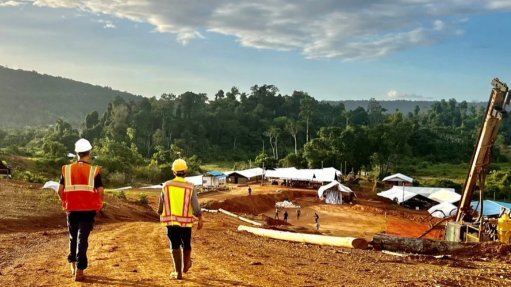Company targets mining industry for its asset management product
Significant interest in the remote management of assets, owing to global financial pressures and labour unrest in the mining industry, has led asset management and consumer solutions provider QCIC Asset Management Solutions to develop its latest fleet management and telemetry product offering, Qic-Fleet.
QCIC tells Mining Weekly that Qic-Fleet, which was launched in July, is ready for marketing to the mining industry.
Qic-Fleet is a vehicle-mounted product that sends data of the vehicle to a computer installed with QCIC’s software.
QCIC director for sales, marketing and new business development Brian McKenzie notes that mining companies are considering asset management for earthmoving and other mining-related vehicles to remain profit- able ventures. Asset management involves several aspects, including the reduction of machine downtime through service schedules, which can be set up on the locally developed Qic-Fleet.
The Qic-Fleet system includes much of the peripheral hardware on board, such as driver identification and management systems, whereas, in the past, a customer was required to buy an additional unit that would be plugged into the Qic-Fleet platform, he explains.
McKenzie says the Qic-Fleet system has an on-board global positioning system (GPS) that tracks vehicles and manages on-site productivity, as it can locate mobile vehicle assets, which can then be rerouted to areas of greater need, by contacting the vehicle operator.
Through monitoring vehicle working hours and revolutions per minute on engines, the system schedules maintenance of the specific asset fleet to limit vehicle break- downs and downtime. Oil pressure and water temperature are also monitored to ensure correct engine management.
The Qic-Fleet also has the ability to record this data, as it can interface with the on-board electronic control module of machinery, such as materials handling or earthmoving equipment, sending controller area network data – which allows devices in a vehicle to communicate – wirelessly through a global system for mobile communications (GSM) network to a mine’s enterprise resource planning management (ERPM) system. The ERPM system then compiles a report on equipment and operator performance, as well as uses of the machinery, McKenzie notes.
Further, Qic-Fleet monitors near-real-time driver behaviour and reports on vehicle speed, as mining sites have strict low-speed zones, owing to safety requirements, he explains. Accountability and visibility are increased, as records of individual operator performances are available. Companies can use this data to identify not only those operators who did not adhere to speed limits but also those who need more training.
Qic-Fleet provides data to help prevent equipment and operator fatigue, says McKenzie, adding that “the data provided by Qic-Fleet has identified trends where operators’ production during the last four hours before a weekend increases dramati- cally, meaning the operator is pushing the equipment harder than what he or she normally would and, thus, may result in injury or machine breakdown”.
McKenzie says this can be problematic, as the entire production cycle will be put under strain. For example, a front-end loader that suddenly increases productivity will force an articulated dump truck (ADT) to move faster, owing to the ADT needing to load and unload more raw materials quicker, which, in turn, will put the crusher and other equipment under production pressure.
Not only will the equipment be under greater strain, but the safety of operators and other labourers at the mine will also be jeopardised, as the likelihood of accidents occurring increases, particularly in cases where operators exceed the set speed limit.
In the event of a vehicle such as an ADT overrevving or speeding, the Qic-Fleet system database will inform the relevant personnel at the mine of the ADT’s location, how long it overrevved or exceeded the speed limit and who operated the vehicle. The mining company can also draw up a detailed report of the ADT fleet and identify the number of instances when overrevving or speeding occurred in a period, which allows mining management to control the fleet more effectively.
The Qic-Fleet system also informs operators through an audible or visual alarm system when the vehicle is overrevving, idling excessively, speeding or is overloaded, explains McKenzie.
He notes that the Qic-Fleet system can be installed on all mining-related vehicles, such as forklifts, handling plant, dozers, loaders, ADTs and cranes, as well as on transport vehicles, such as buses, used by mining companies to transport labourers to and from mines.
Qic-Fleet has the ability to track, record or report live on tyre pressure and gear-shift changes and is capable of delivering a full crash analysis report and graph for investigation purposes after an incident occurs.
Cross-Border Tracking
“The development of the Qic-Fleet system began ten years ago and has evolved from a passive, data-gathering on-board computer to a live GSM and general packet radio service (GPRS) reporting platform,” he notes.
McKenzie adds that the Qic-Fleet uses GSM and satellite-based connectivity options to allow for vehicle tracking and management in remote locations in South Africa and across the border in areas that do not have GSM connectivity. GSM and GPRS connectivity is the preferred connectivity option, as larger packets of data can be sent using these systems and it is cheaper than satellite connectivity.
“Visibility of mobile assets is important for companies, such as South Africa-based construction contractor Murray & Roberts and CAT Rental Store, as they need to know where a vehicle is at all times and be able to bill a client or contract on actual engine hours worked. Some of these equipment pieces operate in remote areas throughout Africa and uninterrupted and reliable communication with the asset locations is of utmost importance,” he says.
McKenzie explains that actual engine hours worked can be calculated by installing specific sensor equipment on engines or reading revolutions-per-minute data. Qic-Fleet communicates the information through GSM or satellite networks to a server and then onto the master-user software platform; from here the data can be filtered and reported to other end-users by means of a computer, tablet or cellphone interface software.
“At State-owned power utility Eskom’s Kusile and Medupi coal-fired power station projects, in Mpumalanga and Limpopo respectively, QCIC is supplying subcontractor Murray & Roberts and Japan-based multi- national engineering and electronics conglomerate Hitachi with the FR460 Qic-Fleet system, which has been installed on a fleet of about 400 assets across both sites,” says McKenzie, adding that Hitachi uses the Qic-Fleet system to monitor productivity, the availability of machinery, breakdowns and the hours worked for internal billing cost centres at the respective power stations.
“Qic-Fleet has been installed on all light-duty equipment, such as generators and compressors, cranes, elevated work platforms and materials handling and plant equipment at the Kusile and Medupi power plants,” says McKenzie.
Automation
McKenzie says the future of the mining industry will be remote mining, whereby operators of mining equipment will no longer be required to physically be in the cabin of the production equipment, such as excavators, loaders and other related equipment, resulting in fewer personnel being required to work on mines. Labourers, such as drillers, will no longer be required, he says, noting that technicians and engineers will be among the few personnel required to work on mines.
“Technology is progressing at such a fast rate that it would be possible to engage in a mining operation remotely. Mining vehicles can be equipped with high-resolution cameras and connected to high-speed fibre optics, or local radio frequency networks that will enable operators to control the equipment from a remote location,” he notes.
“An operator in an openpit mine, for example, would sit behind a tempered-glass room in full view of an ADT. The operator would have the ability to control the ADT remotely, drive it to the loading area and switch control from the ADT to a loader, which would then load the ADT with raw materials.
“Once the ADT has been loaded and the loader parked, the operator can put the ADT on a preprogrammed route using differential GPS coordinates at a set speed, lowering cases of speeding and operator risks,” he concludes.
Comments
Press Office
Announcements
What's On
Subscribe to improve your user experience...
Option 1 (equivalent of R125 a month):
Receive a weekly copy of Creamer Media's Engineering News & Mining Weekly magazine
(print copy for those in South Africa and e-magazine for those outside of South Africa)
Receive daily email newsletters
Access to full search results
Access archive of magazine back copies
Access to Projects in Progress
Access to ONE Research Report of your choice in PDF format
Option 2 (equivalent of R375 a month):
All benefits from Option 1
PLUS
Access to Creamer Media's Research Channel Africa for ALL Research Reports, in PDF format, on various industrial and mining sectors
including Electricity; Water; Energy Transition; Hydrogen; Roads, Rail and Ports; Coal; Gold; Platinum; Battery Metals; etc.
Already a subscriber?
Forgotten your password?
Receive weekly copy of Creamer Media's Engineering News & Mining Weekly magazine (print copy for those in South Africa and e-magazine for those outside of South Africa)
➕
Recieve daily email newsletters
➕
Access to full search results
➕
Access archive of magazine back copies
➕
Access to Projects in Progress
➕
Access to ONE Research Report of your choice in PDF format
RESEARCH CHANNEL AFRICA
R4500 (equivalent of R375 a month)
SUBSCRIBEAll benefits from Option 1
➕
Access to Creamer Media's Research Channel Africa for ALL Research Reports on various industrial and mining sectors, in PDF format, including on:
Electricity
➕
Water
➕
Energy Transition
➕
Hydrogen
➕
Roads, Rail and Ports
➕
Coal
➕
Gold
➕
Platinum
➕
Battery Metals
➕
etc.
Receive all benefits from Option 1 or Option 2 delivered to numerous people at your company
➕
Multiple User names and Passwords for simultaneous log-ins
➕
Intranet integration access to all in your organisation


















